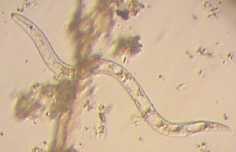Caenorhabditis elegans
Caenorhabditis elegans is a species of roundworm or nematode. It is important because much research has been done on its genetics and development.
| Caenorhabditis elegans | |
|---|---|

| |
| An adult hermaphrodite C. elegans worm | |
| Scientific classification | |
| Unrecognized taxon (fix): | Nematoida |
| Phylum: | Nematoda |
| Class: | Chromadorea |
| Subclass: | Chromadoria |
| Order: | Rhabditida |
| Family: | Rhabditidae |
| Genus: | Caenorhabditis |
| Species: | C. elegans
|
| Binomial name | |
| Caenorhabditis elegans | |
| Subspecies | |
C. elegans is about 1 mm long. The worms are not parasites, they are free-living. They live in soil and feed on bacteria. C. elegans is a model organism, used to study animal development and behavior. It is the first multicellular organism for which scientists have been able to sequence its whole genome.
C. elegans has two types of sex: hermaphrodite and male. A hermaphrodite makes sperms when its in a larval stage and makes ova in an adult stage. A male can only make sperm. Males are a little smaller than hermaphrodites.
Study using C. elegans was begun in 1965 by Sydney Brenner. In laboratories, they are easy to keep alive. At 25ºC, they spend 14 hours as an embryo. Animals like C. elegans that do not take long to grow and are easy to feed are usually good organisms for research.
In 2002, the Nobel Prize for Medicine was awarded to Sydney Brenner, Robert Horvitz, and John Sulston for their work on how C. elegans's genes cause it to grow and cause some of its cells to die.
Caenorhabditis Elegans Media
Video of C. elegans with pencil for scale
Asymmetric cell divisions during early embryogenesis of wild-type C. elegans
References
- ↑ Maupas, É (1900). "Modes et formes de reproduction des nématodes". Archives de Zoologie Expérimentale et Générale. 8: 463–624.
- ↑ Les modalités de la reproduction et le déterminisme du sexe chez quelques nematodes libres. Nigon V. Ann. Sci. Nat. Zool. Biol. Anim. 1949;11:1–132.
- ↑ Moerman, D. G.; Waterston, R. H. (1984). "Spontaneous Unstable UNC-22 IV Mutations in C. ELEGANS Var. Bergerac". Genetics. 108 (4): 859–877. doi:10.1093/genetics/108.4.859. PMC 1224270. PMID 6096205.
- ↑ Tc1 transposition and mutator activity in a Bristol strain of Caenorhabditis elegans. Babity JM, Starr TV and Rose AM, Mol Gen Genet., 1990 June, 222(1), pages 65-70, PubMed
- ↑ Structural analysis of Tc1 elements in Caenorhabditis elegans var. Bristol (strain N2). Harris LJ and Rose AM, Plasmid. 1989 Jul;22(1), page 10-21, PubMed
| Wikispecies has information on: Caenorhabditis elegans. |
| Wikimedia Commons has media related to Lua error in Module:Commons_link at line 62: attempt to index field 'wikibase' (a nil value).. |






